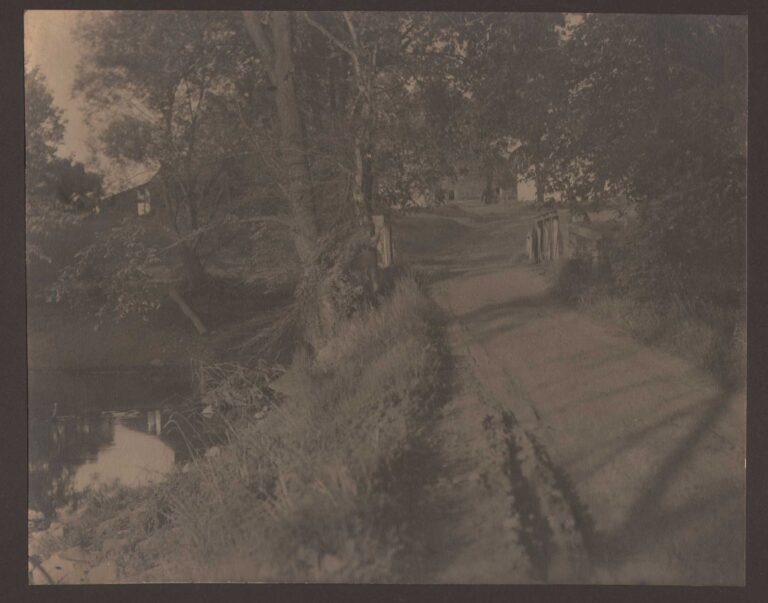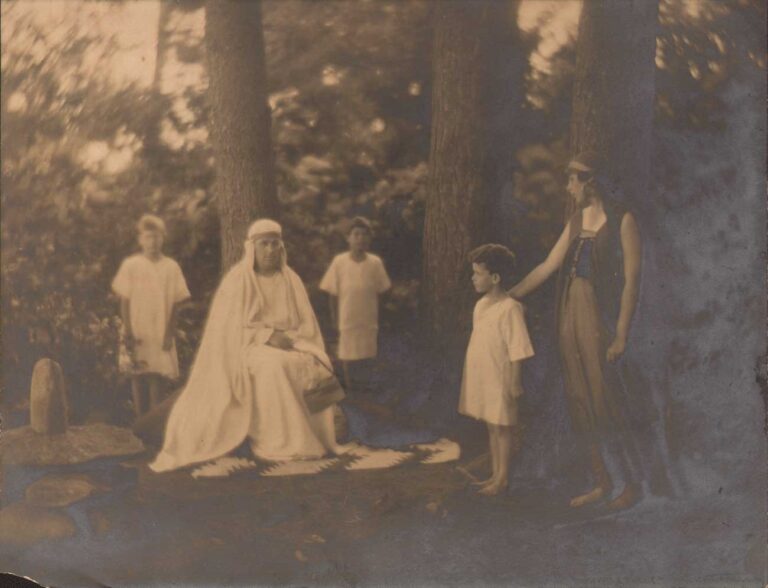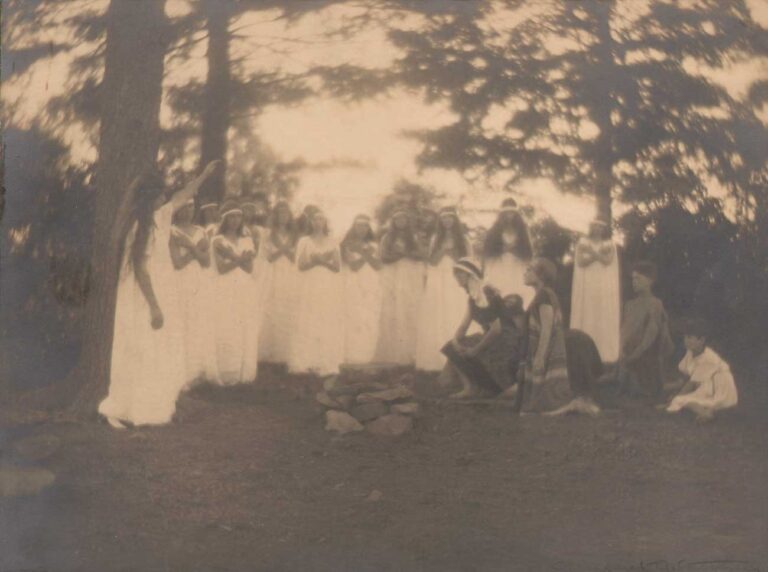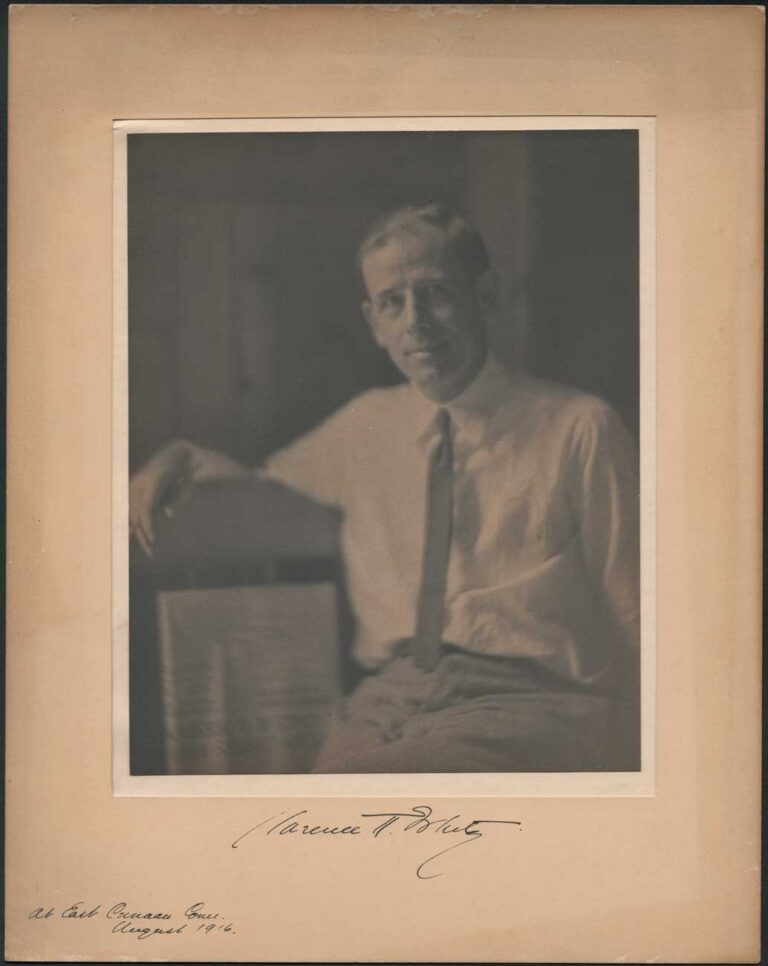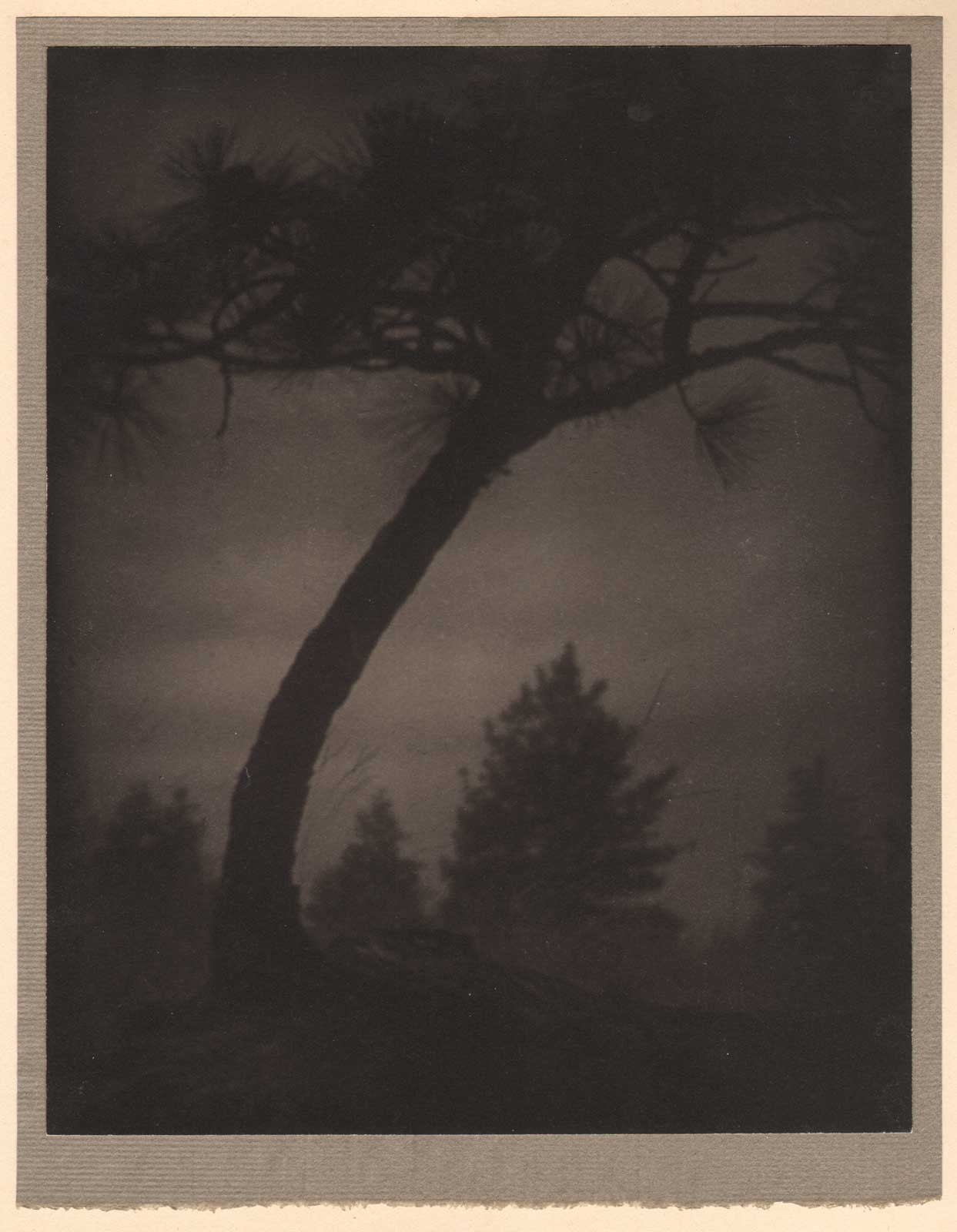
The Hour of Twilight
Showing a leaning pine tree silhouetted against a grove of pines, this is one of the better-known photographs taken by William Gordon Shields, with this being the original exhibition platinum print of the image entered in the 1916 Pittsburgh Salon (entry #244) held at the Carnegie Art Galleries in Pittsburgh, PA from March 2-31. The following details are printed in black ink on the backing board verso:
The Hour of Twilight
By
William Gordon Shields
Room 3405
120 Broadway
New York City, N.Y.
No. 1
$25.00
Return to above address
pasted along lower margin is the original white label (trimmed) for the Pittsburgh Salon:
No. 244
This is to certify that this print
was accepted by
The Committee of Selection
And hung in the
1916 Pittsburgh Salon
Carnegie Art Galleries
Pittsburgh, PA.
C. E. Beeson Secretary
Besides Pittsburgh, the work was also exhibited that year in London as part of the 61st annual exhibition of the Royal Photographic Society. The English publication The Connoisseur weighed in in a review:
Quite Japanese in feeling was the Hour of Twilight, by Mr. W. Gordon Shields, showing some picturesque sprays of foliage silhouetted against an evening sky. (p. 110)
Later, for the 1921 annual Pictorial Photography in America, where the work was reproduced as a full-page halftone reproduction, Shields discussed his working methods in the darkroom with a nod to the work:
From A “bathroom” Expert
I never at any time have had a regular dark room, practically always changing my plates and reloading holders at night in total darkness. When developing plates or enlargements, I take possession of the bathroom, place a wide board across the tub on which are placed the necessary trays, see that the room is absolutely dark, and go ahead. I usually tank my plates and films and use Azol for developing, sometimes Pyro.
Most of my exposures are made with an Adams Minex Reflex camera, quarter plate size. This camera cost about three hundred dollars before the war, and I have found it well worth the expenditure. It has a Ross Zeiss Tessar lens, which I seldom use, being quite content with the work of my Smith single F4.5 lens, which I carry in the camera all the time with a three-times light filter attached. My only other camera, which I use a great deal, is a Newman & Guardia “Baby Sybil” with Carl Zeiss Tessar F 4.5 lens, taking a picture 4.5 x 6 cm. This does wonderful work, the negatives easily enlarging to 11 x 14 and over. I use the Standard Orthonon plate and Premo speed film pack, always giving a full exposure. My favorite printing processes are multiple gum and bromoil, three or four printings in the former, nearly always from enlarged paper negatives up to 11 x 14 from either camera.
“The Hour of Twilight” is a triple printing in gum, and was made with the Adams Minex on a Standard Orthonon plate, using a Smith single lens. (p. 14)
William Gordon Shields: American, born Canada: 1883-1947
Born in Hamilton, Ontario Canada, William Gordon Shields (1883-1947) was an important amateur photographer who emigrated to America around 1910. He would go on to make a name for himself as an important participant and exhibitor in pictorial photography circles centered in New York City. Financially independent while employed as early as 1915 with the American Smelting and Refining Company headquartered on the 34th floor of the newly-built Equitable Building on lower Broadway in NYC, (1940 US Census lists him as Assistant Secretary to the firm) he spent his free time affiliated with other like-minded “Photo Craftsmen of New York” who aligned themselves with Edward R. Dickson, the editor and publisher of Platinum Print, a publication subtitled A Journal of Personal Expression, first published in November, 1913.
In 1915, Shield’s work was exhibited as part of the journal’s “Platinum Print Collection” at the annual Pittsburgh Salon. Soon thereafter, he became an active member of the Pictorial Photographers of America, (PPA) founded by Clarence H. White in 1916, whose mission by fellow founding member Dickson stated it was an “Association having in mind solely the development of the art of photography from a standpoint of educational value.” The PPA held meetings at the National Arts Club in New York City, and Shields is listed as a member by June, 1917 in a list published that year in the journal Photo=Graphic Art, (Oct. 1917) the successor to Platinum Print. Soon, Shields was becoming more involved with the PPA, and he is listed as being a member of the Association’s Executive Committee as printed in Pictorial Photography in America, the groups first annual published in 1920.
The following is a short, albeit incomplete timeline of major dates in the photographic life of William Gordon Shields. For an authoritative look at his career, please consult Pictorial Incidents: The Photography of William Gordon Shields by Michael Bell: 1989: Agnes Etherington Art Centre, Queen’s University Kingston, Ontario, Canada.
1883: born Feb. 4th in Hamilton, Ontario Canada to James Williams Shields and Fanny Geiss.
1910: arrives in New York City.
1914-15: Exhibits work in the Eleventh and Twelfth Salons of the Toronto Camera Club in Canada. A Pictorial Incidents footnote states nine works by the photographer were accepted for the 1914 Salon.
1916: Invited to exhibit as part of the 26th annual Exhibition of Pictorial Photography at the Brooklyn Museum (sponsored by the Department of Photography at the Brooklyn Institute of Arts and Sciences) from April 27-May 21. Exhibited works:
131. Sunshine in Spring
132. A Girl of Sicily
133. The Hour of Twilight
1917: The Photographic Journal of America publishes the following editorial commentary by Wilbur H. Porterfield concerning Shield’s work as it appeared in the Pittsburgh Salon:
“The Doorway of St. Patrick’s Cathedral, New York,” by William Gordon Shields, is enriched by natural light and refinement of tone, and shows a keen sense of the correct placing of “spots” in the manner in which he “caught” the pedestrians present at the moment of exposing the plate. Also worthy of note is “Heart of the Woods,” “Madonna of the Shadow,” and “Washday in Little Italy,” in each of which there is agreeable composition and the stamp of artistic personality.
1919: Shields, along with Dr. A.D. Chaffee, James Capello, Alfred Cohn, Bernard S. Horne, Dr. Charles H. Jaeger and Doris U.(lman) Jaeger exhibits oil and bromoil prints at the Clarence H. White School of Photography at the Washington Irving House. Around 52 prints were shown. (May issue: The Photo-Miniature)
1919: Exhibits the following three photographs in the Canadian National Exhibition in Toronto sponsored by the Toronto Camera Club in late August to early September. (International Exhibition of Photography)
212. The Woolworth Building. (Oil.)
213. Full Blast in Wartime. (Oil.)
214. A Memory of the Past. (Oil)
1919: December 1: marries Huguenot Park (Staten Island) resident Gladys Caroline Hastings (b. 1894?) in New York City.
1922: exhibits three gum prints as part of 162 shown by members of the Pictorial Photographers of America marking the occasion of the opening of The Art Center in New York City.
1922: Listed in the September issue of Camera Craft magazine as Director for America for the newsletter The Club Photographer, published in Liverpool, England. It was issued monthly and featured “Contributions And Pictures By the Most Famous Workers.” The April issue included an article penned by Shields.
1940: US Census lists Shields as the Assistant Secretary for “Smelting Mining”. He resides in the NYC borough of Richmond on Staten Island along with wife Gladys and his younger sister Emma, whose occupation is listed as a retail knitting instructor.
1947: Dies at 64 years of age on March 13. At the time he was still working as the Assistant Secretary for the American Smelting and Refining Company headquartered in NYC and living at 678 Huguenot Ave. on Staten Island. He is buried in Moravian Cemetery on the island.
Working Methods: William Gordon Shields
The following flattering profile on the photographer penned by architectural photographer John Wallace Gillies appeared in the August, 1915 issue of the Boston journal American Photography:
Amateurs I have Known: William Gordon Shields
If you should explode a bomb under William Gordon Shields, he would probably turn quietly around and ask you, again quietly, what all the excitement was about; that is, if you could, by such simple methods, arouse that much curiosity in him. However, probably you will never have the opportunity to touch off a bomb under Mr. Shields, so you must take my word for what I am saying. What I am trying to get at is the fact that Mr. Shields is a quiet sort of chap, not easily aroused, devoid of emotion to outward appearances. A Canadian by birth, he is more English, by habit, than an Englishman.
I do not mean to convey the impression that Mr. Shields is minus emotion. That is not so. He merely appears to be minus emotion, something like the Sphinx. The only reason I can believe that he experiences feeling is by his pictures. You can tell a great deal about a man by looking at his pictures. So, in spite of all I have said, Mr. Shields has emotions, and they show only in his pictures. They are not the harum-scarum sensations that you might expect of certain people, but nice, orderly, well-conducted feelings, which do not jump over the traces. Mr. Shields never has spasms of feeling, so to speak. Now, when I say that Mr. Shields is blest with a quiet, orderly disposition, I would not intimate that he is slow in either thought or action. He is in speech, for he thinks ten times before he speaks once. Deliberate on most occasions, when a necessity arises he can move with the speed of light, and many of his pictures indicate this characteristic seizing of opportunity in a jiffy.
The town of Hamilton, Ontario, had the good fortune to produce Mr. Shields, and about five or ten years ago he journeyed to New York and has been associated with the American Smelting and Refining Company ever since. I do not think he owns the company, but I do know that he is a very important person. He has been making photographs for many years, perhaps ten or twelve. He spent most of them making average photographs which had nothing special to say, but in the last two years he has found himself—there has been a change.
The whole thing was caused by the purchase of a Smith lens — a 9-inch Doublet. I had a hand in this, and was instrumental in precipitating the purchase of a soft-focus lens; I recommended a Verito at the time, but, more by good luck than good judgment, Mr. Shields bought a Smith. He did not know anything about it at the time, but just happened to guess right. From that day he began to make pictures.
Here it is well to discuss a thought which has always been in my mind. The booklet of the Smith lens states that a man without an artistic soul had better not use the lens. In other words, if you cannot make pictures, do not buy the lens. Mr. Shields never made pictures consistently until he got the Smith lens. One cannot make pictures without the lens, and yet you are advised not to buy it until you know how to make pictures. You must not buy one until you know how to use it: how are you going to learn?
Anyway, Mr. Shields makes pictures, and good ones. Shortly after the advent of the 9-inch Doublet, he became acquainted with Edward R. Dickson, Clarence H. White and others of the little circle of accomplished picture makers who are setting new standards to work to in photography. Then his real knowledge of picture making developed. Where once he was satisfied to make a reproduction by photography, now it must be an interpretation, though still done by photography. He desires a picture, and photography is but a step to an end.
An Adams Reflex camera, quarter plate size, is his pet weapon, fitted with a 9-inch Smith lens. He has a Carl Zeiss Tessar which fits on the camera, but I have never seen him use it. He says it works well in making enlargements from negatives made with a Smith lens. Naturally he prefers platinum to all other methods of printing, although he still harbors a leaning toward kallitype, with which he has messed for over a year with fair success. Also, he is not convinced that bromide is not a perfectly good way to make his prints, but platinum he prefers over all. (pp. 482-84)
